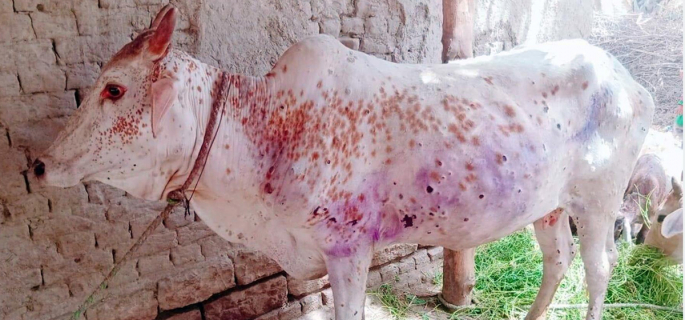
OR
Opinion
Lumpy skin disease in cattle and economic losses
Published On: August 22, 2023 09:00 AM NPT By: Dr Kedar Karki

Dr Kedar Karki
The author is a senior veterinary health management consultant. He runs Devine veterinary clinic in Sinamangal, Kathmandu.news@myrepublica.com
The lumpy skin disease (LSD or dermatitis) first appeared in an epidemic in 1929 in Zambia. At first, it was thought to be the result of hypersensitivity to venom or insect bites. The LSD spread across Africa between the 1950s and 1980s, affecting cattle in Kenya, Sudan, Tanzania, Somalia and Cameroon. In 1989 there was an outbreak of LSD in Israel. This outbreak was the first instance of the LSD north of the Sahara desert and outside the African continent. This particular outbreak was thought to be the result of infected Stomoxy calcitrans carried by wind from Ismailia, Egypt. Lumpy dermatitis is a vector-borne smallpox disease of domestic cattle and Asian water buffalo and is characterized by the presence of skin nodules, which causes natural infection in cattle.
Historically, the LSD was limited to Africa where it was first discovered in 1929. But in recent years, it has spread to other countries. It wreaked havoc in Turkey and Greece in 2015 and the Balkans, Caucasian countries and Russia in 2016. Since reaching Bangladesh in July 2019, it has spread to other Asian countries. According to the risk assessment report of the Food and Agriculture Organization (FAO), by the end of 2020, this disease has spread to seven countries in Asia: China, India, Nepal, Taiwan, Bhutan, Vietnam and Hong Kong. Also, at least 23 countries in Southeast Asia are at risk of LSD. In Nepal, more than 48,000 cattle have died till date from the lumpy skin disease that has affected all of the country’s 77 districts. According to the latest data available with the Department of Livestock Services, 48,133 cattle have died and 1,054,055 have been infected by the highly contagious viral disease since its outbreak in April.
According to an FAO study: “Given the gap between demand and supply of animal protein in Bangladesh and the disparity in livestock prices in India, informal export of livestock has occurred. Cattle are sent from India to many districts of Nepal, especially from the border of Bihar, and this work is done on foot. This may also have contributed to the spread of the infection.” Lumpy dermatitis does not affect humans.
The lumpy skin disease spreads rapidly in cattle in the summer season. It is a viral (transmitted by a virus) disease in which lumps form in the body of cattle and pus starts coming out due to which the animals die. This disease is transmitted by a virus in animals, commonly known as nodular skin disease by cattle breeders. This disease usually affects cows and buffaloes. LSD is transmitted from one animal to another by blood-sucking flies, mosquitoes, and ticks. This disease is not transmitted to humans, but it is transmitted very quickly from one infected animal to another. Due to this disease in the animal husbandry industry, there is a decrease in milk production, reduction in the fertility of cows and bulls, abortion, skin damage, weight loss or gain and in some cases even premature death.
Due to the attack of this disease, lumps are first formed on the cattle's body, then the wounds become bigger. If the wounds are not treated, worms enter them, which weakens the cows and bulls. Therefore, to prevent the disease from spreading, the animal should be treated as soon as it becomes infected. Also, along with cleanliness, sick cattle should be kept separate from other animals because it is a disease that can be transmitted from one animal to another. The onset of the disease is characterized by high fever and swelling of lymph glands 0.5 to 5.0 cm in diameter in the skin. These nodules can be found all over the body, but are especially common on the head, neck, nipples, testicles, and the area between the anus and the scrotum or vulva (perineum). Sometimes the entire body is covered with lumps. If it spreads to the respiratory tract, breathing becomes difficult and death can occur within 10 days. Abortions can also occur in pregnant animals.
Risk factors:
Environment – high number of vectors, presence of suitable breeding sites for vectors (flowing water and dung), grasslands suitable for ticks, cattle transport routes etc.
Climate – High temperature and high humidity of the environment leads to a high vector population which ultimately leads to high LSD cases.
Movement of cattle from affected areas to disease-free areas: Trade, grazing, nomadic farming, legal and unauthorized cross-border movement of animals, lack of testing regime for imported animals, etc.
Low/no immunity against LSD: Fully susceptible cattle population, cattle vaccinated but not yet protected, vaccination stopped, poor vaccination coverage, vaccination records not kept.
Farming method: Contact with neighboring herds, purchase of new animals from unreliable sources, use of local breeding bulls, cattle not monitored regularly, sharing of veterinary medicine or other equipment.
Differential diagnosis:
Severe LSD is very different, but mild forms can be confused with the following diseases: Bovine herpes mastitis (bovine herpesvirus 2) (sometimes called pseudo-lumpy dermatitis). Bovine papular stomatitis (parapoxvirus), pseudopoxvirus (parapoxvirus), and cowpoxvirus (orthopoxvirus), dermatophilosis, basonitosis, rinderpest, hypoderma bovis infection, photosensitization, urticaria, skin tuberculosis, and onchocercosis.
If the animal is treated in the first few days, the disease can be checked. But most people do not give importance to skin diseases in cattle. Insects like flies, mosquitoes are more common in the tropical climate of India and Nepal. Unseasonal rains and floods will provide a favorable environment for their growth, so that the carriers of this infectious disease will not be eradicated soon. Obviously, this will have a devastating effect on the country, where most of the dairy farmers are either landless or marginal landlords and milk is one of the cheapest sources of protein available to them.
The contagious nature of the lumpy skin disease causes significant economic losses due to persistent debility, slowed development, decreased milk and meat output, hide damage, and sterility in bulls, infertility, abortion, and different ranges of mortality and morbidity. The World Organization for Animal Health (OIE) has declared it a notifiable disease (legal reporting to government authorities). This means that any country must inform the OIE of any outbreak of the disease, so that its spread can be prevented. However, there is no real data available with the Animal Husbandry Development Department about the actual incidence of LSD in the country or the economic loss to farmers.
You May Like This

Govt. to give compensation for losses caused due to lumpy skin disease
KATHMANDU, Aug 29: The National Development Action Committee has decided to sort out the issues of electricity wire, telephone cable... Read More...

Lumpy skin kills 5,700 plus cattle in Lumbini; infection rate slows
LUMBINI, Aug 8: Since the outbreak of the lumpy skin disease, a total of 5,748 cattle died of the disease... Read More...

Tackling the surge of Lumpy Skin Disease
The recent outbreak of lumpy skin disease in Rasuwa district has sent shockwaves through the local farming community, with 159... Read More...





Just In
- School Principal arrested for allegedly facilitating fake examinees in Grade XII examination
- Stepdaughter arrested on charges of murdering her mother
- Five shops and a vehicle workshop gutted in Shankhamul fire
- Two agreements between private sector entities signed at Nepal Investment Summit
- Shrestha appointed Acting Chairman of JSP
- World Day for Safety and Health at Work being observed today
- Almost all sectors of Nepal are open for foreign investment: NC President Deuba
- Second T20 match: West Indies ‘A’ sets 161-run target for Nepal







-1200x560-wm_20240427144118.jpg)





Leave A Comment